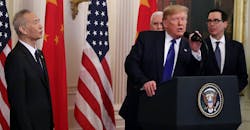From 'Disappointed' to 'Indisputable Win': Mixed Reviews on Trade Deal
In a ceremony at the White House January 15th, President Trump signed the first phase of a trade deal with China. According to the Wall Street Journal, the initial agreement includes an end to tariff threats, intellectual property protections and substantial promises by the Chinese to purchase American agricultural and manufactured goods.
Although the text of the agreement has not yet been released, sources cited by Reuters said that China pledged to buy nearly $80 billion worth of manufactured goods over the next two years. The promised purchases include “significant” numbers of cars, car parts, aircraft, agricultural machinery, medical devices and semiconductors. More specific numbers were not available.
The National Association of Manufacturers, in a statement, hailed the “unprecedented” agreement. “No other administration has achieved this level of success with—and accountability of—America’s primary economic adversary in the past three decades,” said NAM CEO and President Jay Timmons. His remark on the timeliness of the deal echoed President Trump’s remark at the signing ceremony that a similar trade deal should have been passed “25 years ago.”
The American Alliance for Manufacturing was less impressed by the deal. In a letter to the White House released January 14th, President and CEO of AAM Scott Paul called the agreement “completely inadequate.” He wrote, “The agreement does not level the playing field for American workers in the U.S. or global market.”
In an interview, Paul agreed with Timmons and Trump about how the trade deal has been sorely wanted since before the current Administration. “These issues have been around for a long time. I mean, some of them have been around for 18, 19 years. I’m not going to pretend like any of these are easy issues to solve.” But he disagreed with them on its efficacy.
Paul’s complaint? The deal, which has been touted by the President as a “breakthrough,” does little to address key issues with the US-China economic relationship, including Chinese state-owned enterprises (SEOs) and heavy subsidies. “By one estimate, it’s about 3% of China’s GDP goes towards subsidizing its businesses. … We operate in a free market here, and we don’t illegally subsidize our firms, so that’s a huge barrier to overcome. That’s not addressed in the agreement.”
SEOs, Paul says, can use tactics like flooding the market with unwanted goods because unlike American companies, SEOs don’t have to be profitable. But China’s overproduction also went unaddressed in the agreement, Paul says, in lieu of agreements to purchase goods: “At the end of the day, it wasn’t, ‘You have to close 60 of your steel mills in China that are churning out steel that nobody wants,’ it was ‘How much American product are you going to buy?’”
Other unaddressed issues, Paul says, include environmental and labor regulations. “China has a different set of standards, and by and large they’re not enforced. A Chinese firm that is using exploitative labor and polluting the environment pays no extra costs for getting its goods into the United States, and that’s another unfair competitive advantage, and another thing that is not addressed through this agreement.”
The NAM expressed similar concerns in a 2018 letter to Trump: “From unfair subsidies and massive overcapacity in sectors such as steel and aluminum, to … market-distorting policies that shield Chinese companies, manufacturers and workers in the United States face an unfair playing field.” Despite apparently agreeing on the problems at hand, Timmons’ 2019 statement disagrees with Paul’s assessment of the deal, calling it “an indisputable win.”
Paul commends the Trump Administration’s use of tariffs, and in his letter he wrote that critics of tariffs fail to understand what’s at stake. A more effective agreement would also use tariffs to generate leverage, but ideally, that leverage would be international: “The part that’s missing, that I think would be really effective, is enlisting more of our allies,” Paul says. “The data shows China was able to export more around the world and make up for some of the loss of the US market. And so [tariffs] weren’t particularly painful to China. But if you had the EU, Japan, the United States and others all applying or threatening to apply tariffs, China knows that would be damaging to its economy.”
Timmons, who was present at the signing of the trade deal, called the deal a “remarkable turning point for manufacturers.” Paul was less certain. “I think the impacts [on specific manufacturers] will vary by a firm’s exposure to China. … For some firms that saw their exports hit by retaliation, they might see a little bit of growth. It’s possible. For firms that are besieged by Chinese import competitions, I’m not sure there’s a lot here for them to cheer about.”
Possibly the biggest benefit Paul saw in the deal was a breather from the word he used to characterize trade in 2019: “uncertainty.” “It might be fair to say there’s a bit more certainty now than, say, 3-4 months ago. But I would again say if things don’t go well in implementing phase 1, we may go back to a period where there are more tariffs. And businesses will have to make an adjustment.”
About the Author
Ryan Secard
Associate Editor
Ryan Secard joined Endeavor B2B in 2020 as a news editor for IndustryWeek. He currently contributes to IW, American Machinist, Foundry Management & Technology, and Plant Services on breaking manufacturing news, new products, plant openings and closures, and labor issues in manufacturing.
